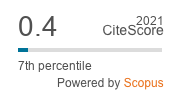Analysis of the boil-off loss in parental and different crosses of bivoltine silkworm, Bombyx mori L.
Abstract
The process of removal of gummy proteinous material (sericin) from the silk is commonly referred to as degumming loss or boil-off loss and is considered as one of the important economic traits during the course of silkworm breeding. Loss of sericin varies with breeds / hybrids, it is essential to analyze the ratio with reference to cocoon shell, as it is the basic raw material for the raw silk to estimate silk productivity of a breed / hybrid. In the present study, boil-off loss ratio in the cocoon shells of twelve bivoltine parental breeds (6 oval and 6 dumb-bell) and newly developed 21 each of different crosses (single, three-way and four-way crosses) of bivoltine hybrids along with control hybrids CSR2xCSR4 and [(CSR2xCSR27)x(CSR6xCSR26)] was analyzed to identify promising hybrids with desired boil-off loss ratio. Heterosis for boil-off loss ratio, shell ratio and raw silk percentage both in parents and all the hybrid crosses was also estimated and discussed. Among the parents, the least value of 21.50% was registered in JPN8 (oval), 22.01 % (S9) amongst dumb-bells and in the hybrids, single-cross hybrid CSR27xCSR26 (23.25%), three-way cross hybrid, (JPN8xCSR17)xCSR26 (22.51%) and four-way cross hybrid [(JPN8xCSR17)x(D13xCSR26)] (22.33%) was recorded. It was observed that some of the different crosses of the hybrids have also recorded desirable heterosis values for boil-off loss trait.
References
Basavaraja, H. K., Suresh Kumar, N., Mal Reddy, N. and Datta, R. K. (2000) Studies on Boil-off loss ratio with reference to the cocoon shell in bivoltine silkworm, Bombyx mori L. Indian Journal of Sericulture, 39(1):60-65.
Datta, R. K. (1992) Guidelines for bivoltine silkworm rearing. Central Silk Board, Bangalore.
Bowman, J. C. (1959) Selection for heterosis. Animal Breeding, 27:261-273.
Fisher, R. A. (1965) Theory of inbreeding. Second Edn., Oliver and Boyd. Edinburgh, pp.150.
Gamo, T. and Ichiba, S. (1971) Selection experiments on the fibroin hydrolyzing ratio in silkworm cocoons and its effects upon the economical characters. Japan Journal of Breeding, 21(2):87-92.
Gamo, T. and Hirabayashi, T. (1983) Genetic analysis of growth rate, pupation rate and some quantitative characters by diallel cross in silkworm, Bombyx mori L. Japan Journal of Breeding, 33:178-190.
Gamo, T. and Hirabayashi, T. (1984) Genetic analysis of the boiling off ratio in cocoon shell by diallel crosses Estimation of combining ability and genetic analysis by diallel crosses in the silkworm, Bombyx mori L. Journal of Sericulture Science Japan, 53(2):114-120.
Harada, C. (1961) Heterosis of quantitative characters in the silkworm. Bullettin of Sericulture Experiment Station, 17(1):50-52.
Jones, D. F. (1917) Dominance of linked factor as a means of accounting for heterosis. Genetics, 2:466-479.
Kannan, A. V. (1986) A short degumming. Indian Silk, 15: 37-38.
Kurusawa, H. (1968) Selection of quantitative cocoon characters in the silkworm – changing of cocoon characters with the selection of floss ratio and lousiness fibres. Journal of Sericulture Science Japan, 37(1):43-50.
Mano,Y., Nishimura, M., Kato, M. and Nagayasu, K. (1988) Breeding of auto sexing silkworm race N140xC145. Bullettin of Sericulture Experiment Station, 30(5):753-785.
Mano,Y., Nirmal Kumar, S., Basavaraja, H. K., Mal Reddy, N. and Datta, R. K. (1993) A new method to select promising silkworm breeds /combinations. Indian Silk, 31(10):53.
Mather, K. (1955) The genetical basis of heterosis. Proceedings of Royal Society, London (B), pp.144.
Naseema Begum, A., Moorthy, S. M. and Nirmal Kumar, S. (2010) Boil-off loss in cocoons and filament neatness of selected breeds of silkworm, Bombyx mori Linn. reared in different seasons. Entomon, 35(1):1-4.
Raghavendra Rao, D., Ravindra Singh, Promalatha, V., Sudha, V. N., Kariappa, B. K. and Dandin, S. B. (2004) Studies on boil-off loss ratio in the cocoon shells of multivoltine and bivoltine hybrids of silkworm, Bombyx mori L. International Journal of Industrial Entomology, 8(1): 101-106.
Sadov,P., Korchgin, M. and Matetsky, A. (1978) Chemical technology of fibrous materials. MIR publishers, Moscow, pp.98-106.
Seetharamulu, J., Sheshagiri, S. V. and Raju, P. J. (2013) Boil-off loss ratio of cocoon shells as selection criteria in the newly developed bivoltine silkworm (Bombyx mori L.) hybrids. International Journal of Industrial Entomology, 26(1): 19-21.
Sidhu, N. S. and Sonwalker, T. N. (1969) A preliminary note on the investigation of degumming loss in indigenous, exotic and hybrid cocoons. Silkworm Information Bullettin 1(1): 39-41.
Sinha, A. K., Sinha, V. S. P., Bramhachari, B. N., Ghosh, A. K. and Sinha, S. S. (1992) Race differences in cocoon shell of mulberry silkworm, Bombyx mori L. Indian Journal of Sericulture, 31(2):168-
Sonwalker, T. N. (1969) Investigations on degumming loss and spinning performance of pierced and cut cocoons in silkworm, Bombyx mori L. Indian Journal of Sericulture, 8(1):43-47.
Yokoyama, T. (1959) Silkworm genetics illustrated. Japan Society for Prom. Science, Tokyo, pp.185.


